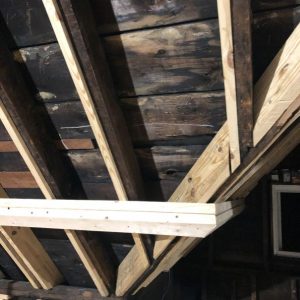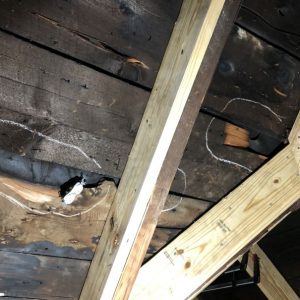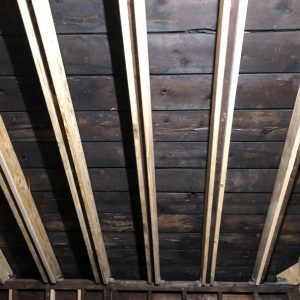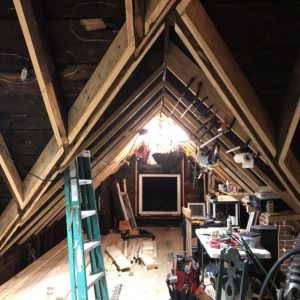Best way to replace old brittle roof sheathing
Dear Forum,
It’s me attic guy again. As always, thanks for all your help along the way. Couldn’t have done this stuff without your expertise–great site. I bought a print subscription to the magazine.
I found a leak today after a big storm. It’s time to fix the roof.
As you can see by the picture, the sheathing is in pretty bad shape in MANY places. This is 1901 sheathing, it is 7/8″ x 11 1/4″ planks. Peices are falling out in places, underlayment is visible in many spots, and honestly even the solid planks seem brittle from years of being…roof sheathing.
—-
Main questions:
Which of these is the best way to go:
1. Remove and resheath? (is this ever done at all?)
2. Completely sheath over existing?
3. Patch where needed?
Can the work be done in stages (new sheathing, new shingles in one part of the roof then move to another face / gable? Or does the entire roof need to be resheathed at once and reshingled? Possibly using flashing lines as break points…i’m not sure exactly how it would work…or if icould work at all.
—
There’s just two of us doing the work, this is probably very significant to the best way to do this…or if to even try to do it at all.
This a 12:12 cross-gable roof, with one smaller doghouse dormer (a nice place to move materials in and out of the attic, i think. But for the big work I was hoping to cut a hole in the roof and pull sheathing up through that, obviously if we do a complete removal it will be a lot easier to do that…anyway, what are your thoughts and suggestions?
I welcome your thoughts, including the idea that we just shouldn’t try this…
Matt
























Replies
Have you priced out the work to a roofer in your area? I’ve been building a long time, there are some jobs that are just better leaving to someone else. Not saying I can’t or you can’t handle the work, but roofers (using my experience) are usually quite affordable. The main reason I like to hire a roofer is b/c they get it done so quickly. Roofers in my area can tear off and replace in one day. This minimizes chance of roof being exposed to the weather and creating costly damages to the home. I’ve found all my roofers by driving around neighborhoods as you can see their work from the street (usually). I avoid the crews that only have 2 people on the roof as they take too long compared to a crew of 5+. Believe me, as a contractor there is nothing more stressful than having a tarp over someone’s roof. Many sleepless nights listening for every gust of wind or anything that sounds like a raindrop. In my opinion roofs need to be done as quickly as possible and most roofers have the same opinion. I do work in a unpredictable and extreme weather environment, so my opinion is based on that.
Just some other thoughts for your consideration.
If you did a complete tear off and re sheath you'd probably have to use solid lumber as your layout wouldn't likely suit plywood. Slow work.
If you have the rafter strength it would be easier to sheathe over the existing with 7/16" plywood or osb. Except for the 12/12 pitch which is brutal work.
Repairing the old sheathing as needed might be a solution but it's unfair to guess just from the pics.
Adding new underlayment and shingles is more straightforward than the sheathing fix, a piece o' cake except for the steep pitch. For sure I would do a side or section at a time with anything less than a big and experienced crew.
A good roofing contractor would be a good idea, if you can afford it.
If not, or if you really want to do this yourself, I would invest in some scaffolding rental, and good safety gear and roof jacks. You have done a lot of work on the house, but hanging on such a steep roof so high in the air is a different experience. Depending on your other time commitments, getting this done in Pittsburgh will challenge your scheduling and work planning skills.
The good part about such a steep roof, is that it has to get pretty bad before it leaks. I think most of your existing sheathing looks ok, but a close look by an experienced professional may be worth getting.
I would replace bad or missing boards with 3/4 inch plywood, which you can cut to width on the ground. You can cut partly good boards in place with a flooring blade in a skilsaw. Span at least three rafters with each replacement section, and stagger the edges. We did the roof on my son's house like this, and it was of similar age, but the roof section we did was much less steep.
Much of the strength of the roof is provided by the sheathing tied to the rafters.
I would hesitate to stage roofing on the attic floor, since the temptation will be to overload the flooring capability.
Cutting a hole in the roof (larger than required to replace rotted or missing wood) would challenge the integrity of the roof structure.
You can do the job in sections, but there will be waste as materials will have to be removed to secure the next section.. You can even do the project over months or years if the condition of the rest of the roof allows it.
But any rental equipment would have to be rented again. Roofing material delivery to the roof is a great thing, but minimums may apply and again increase costs.
Measure twice and cut once. Get several estimates from roofers.
Guys, I really appreciate all of these responses. Good stuff. Thanks for taking the time to respond.
Matt
Plywood would only be 1/2 as strong for the same thickness as the original planks and assuming the same wood species. ...but still, maybe strong enough considering rafter spacing.
Be careful putting plywood over those planks. If there is dry rot, you could be setting yourself up for continuing and escalating problems. Might be easier to simply pull it all off and re-sheath rather than doing extensive "cutting-out" and patching and hoping that there aren't mold spores still hanging around.